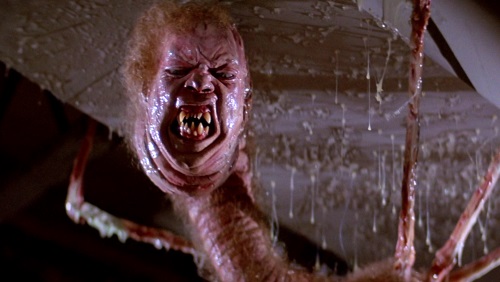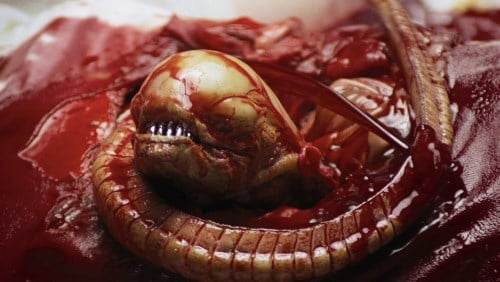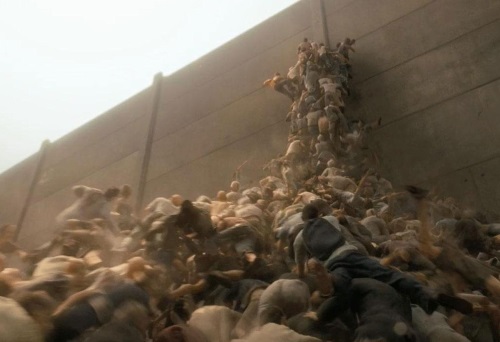
There are creatures whose hunger knows no satisfaction. These creatures intend to fulfill this hunger with insatiable abandon. Once they acquire someone – or something – to host them, the party is sure to go long, and make a nasty mess.
And, no, it isn’t your 20 year old son living in your basement. But I am glad your brain is thinking one step ahead!
Meet the Parasite
Erm, on second thought, that might not be such a great idea. And you’ll soon find out why. Parasites, no matter how big or small, are terrifying creatures with literal stomach-churning lifestyles. And you need not look far into the imagination to craft an idea of what one can do, for there are plenty of them on our very green Earth that are the stuff of nightmares.
And that, my friends, makes them superb candidates for grim, dark writing.
Let us begin with a *mild* parasite – the tapeworm. It enters the body via undercooked foods, and finds a nice comfy spot in your intestines to set up camp. During its life, it will grow by feasting upon what you eat before your body can make most of the nutrients, extending and contorting to the shape and flow of your innards – upwards of fifty (50) feet long!
That’s longer than the width of my house.
And that’s only one. It will breed. And its spawn will do the same, endlessly, resulting in not only the world’s most horrifying version of liposuction, but in a long, slow death until you are nothing but a used up husk. A worm does this. A worm.

Consider the smaller-than-chocolate-chip tick, whose burrowing bite can transmit a plethora of life-altering diseases as it feasts upon your blood. And there’s around 900 different ticks to choose from! Well, now that I think about it, it’d be the other way around. Skin crawling yet?
Now, if you still have an appetite, let me ruin it.
You wake. You suddenly find yourself tied to a chair, naught but a single dim bulb buzzing above you. Weeks could have gone by and you would be none the wiser. You try to move your head but you cannot, for it is quite tightly fastened; to what, you cannot tell. Suddenly a hand from the darkness appears, dangling food above you. There is a red button. It is within finger’s length. Beneath it an old, peeling tape label that reads “eat” in chicken-scratch handwriting. Taking this as your only opportunity to eat, you open wide, and press the button.
What you thought was food begins to squirm and flail sprouting limbs from its underbelly, grasping for the hand that holds it. The Hand releases. Before you can close your mouth, another hand forcibly holds your jaw wide, no matter your violent protests of every muscle in your body.
What you thought was food begins to crawl around your mouth, and begins feasting upon your tongue. The agony lasts for what seems like an eternity. But soon it is over. But the creature is not gone. Every minute of every timeless day you feel its little, pokey limbs stab this way and that as it makes a home… out of your tongue. In your mouth.
The hand returns some considerable time later, this time with a fresh slice of pizza. This is no parasite. You slam the red button repeatedly, and again your mouth is forced open. You try to eat, crunching down as you try, but you find that you swallow very little of the pizza.
The creature is eating your food. In your mouth. Attached to what’s left of your tongue.
Some would call that a horror story; others a sadistic product of evolution. But that is the unfortunate life of a fish the moment it gulps down on a tongue-eating louse.
Parasites are the ultimate anti-organism. They do not think. They do not feel for their hosts. They care not for good or evil, morality or motive. They know but three words: Consume. Adapt. Multiply. They are horror incarnate. And they are beneath your skin – an alien menace crawling, feeding, and breeding within your flesh.
The parasite is a great template for the imagination. It attacks the psyche with the vulnerable threat of being prey to an impossible predator.
That’s without the magic of fiction, I might add.
Now that you have an unsettling taste of what real-world parasites are capable of, let us delve deeper into the monstrous and bizarre that dwell in the darker regions of fiction so that we may better craft our own hungry, little devourers.
Will you create the next ultimate space-terror the likes of the xenomorph of Alien?
Or are you considering something a little closer to the heart, like the shambling corpses of The Walking Dead?
Perhaps you seek something on a grander scale, a galactic scale? There we have the planet-eating species of the Zerg from Starcraft as well as the Tyranids of Warhammer 40k.
If you want to try a bit of everything at this parasitic smorgasbord, the ancient and endless Flood of Halo might just slither and munch its way into your heart.
Make the Audience Squirm
What makes a parasite so terrifying is its ultimate invasion of your privacy. Of your personal space. Of your mind.
It doesn’t hate you. It just needs to eat. Nothing personal, right?
Then we’ll make it personal – up close and personal!
And this is what you must master in order to bring them to life on paper.
During The Thing the parasite assumes the entirety of its host. The host would show no signs of infection until the parasite had no other option than to reveal itself. Your best friend could have been infected the entire time, and you wouldn’t have known until it was too late.
The Thing made its victims forsake one another, inflicting them with the urge to betray one another in order to survive. The Thing made the characters betray their trust in their comrades. Who wasn’t really who they appeared to be? Was it him, was it her? It made it not only a game of survival, but a paranoid, mental gymnastic event.
But what was the worst of it all?
Imagining what it would do to you.

It’s a sick game of psychological warfare that is an unintended, but terrible, weapon in their arsenal. You must harness this effect and merge it with their identity. Force your way into the reader’s mind, attack their psyche by asking yourself how it would feel to be the victim of your terrible creature. What paling experience could it have been to host such a creature? What would it – could it – do to you?
The methods the parasite deployed over the recent years grew more cruel, more heart-wrenching, and more devastating to the human condition. They began to target our children like in the beginning of Dawn of the Dead, or infect our animal-companions like the poor sled-dogs in The Thing. They brought to the table controversial issues that made you think. The parasite made us question our own reasoning and humanity.
Could you shoot your own friend? What about a coworker suddenly taken by the infectious creature? Could you look in the eye at what used to be your own flesh and blood and end them? What if they begged you for the mercy to end their torment?
A slow-acting parasitic infection could leave the afflicted in a dreadful limbo for hours fighting the surrender of his or her body. To watch yourself violently transform into the ultimate horror, unable to resist what had been forced upon you – knowing what you would become the entire time – would be an unthinkable kind of personal hell. Make your readers feel they are trapped inside it, too. Depictions of the agonies – psychological and physical – in explicit detail will wrench out every drop of horror your creature brings to your story.
With Alien the perverse nature of the parasite came to fruition. Alien combines dark, sexual undertones with phobias of parasites to make the audience as uncomfortable as possible. Once the Xenomorph of Alien finds itself in a new area, whether it be Earth or the hold of a cargo ship, its senses kick in, and it prepares for expansion. It makes a nest to breed. Next it seeks food for its young. So it searches for any meat sacks unlucky enough to cross paths with it. But instead of killing its prey, the Xenomorph has its facehugger counterpart impregnate the victim. Most are impregnated unknowingly, waking with extreme hunger for what seems to be no apparent reason. Soon the infantile chestburster will try to exit its host, hence the name.

Imagine something trying to burst out of your chest. Would it gnaw its way through you? What thoughts – what unthinkable sensations would you be experiencing?
Is it better to die to the creature or by your own hand, or to wait for the inevitable death of what is to come? Such was the definitive question heroine Ellen Ripley was charged with answering in Alien 3, and her response – leaping into a gigantic furnace with a Queen Xenomorph inside of her chest – immortalized her character.
Zombism
One of the most popular representations of parasitism is the zombie. Once the night of the walking dead trope evolved into the all-consuming super-virus present in films such as Dawn of The Dead and 28 Days Later, parasites were in the spotlight for the first time since The Thing.
Although some fantasize of the zombie apocalypse, and others literally make money romanticizing it, there’s got to be more than killing cannibal corpses. What makes these parasites so tantalizing?
Simple. We made them more human. More human than we’d like.
We turned the undead from spooky, scary skeletons into our neighbors. Our friends. Our family. No longer do you fear the dead rising from the earth, but you fear your closest loved ones transforming into someone else – something that wants to eat you. Something that needs to eat you. Something with the face of your mother or daughter transformed, warped into a hellion of primordial instinct and rage.
As a kid, I always laughed at the thought of the walking dead. They were dumb, mindless, and slow. Anyone with a baseball bat would be substantially well off. You’d be fine if you avoided the crowds, right?
Then I saw them run. Then I saw them pile and trample over one another to feast on fleeing characters. I saw them climb atop one another in Day Z to scale the great walls around Jerusalem. I pissed myself.

The parasite finds the kinks and gaps in your mental armor, and weasels its way into every weakness to abuse every fear. No matter what defense you build, it must find a way to eat what’s behind it.
Undeath is an unpleasant term. The absence of a spirit within a human. A human without humanity. What sensation would it be like to be turned?
The zombie had become a super-predator with the parasite at the helm. The zombie was no longer a shambling horde, but a ravenous swarm. Some parasitic possessions took hours, with the afflicted characters suffering with the slow surrender of their will to the virus spreading throughout their bodies. Some, with a single bite, transmitted a super-virus that infected the host within moments. Your friends were now potential enemies. Your communities were now cannibal armies in waiting.
And it made the parasite much more lethal by taking direct control over its host with a single bite – a single transmission. A single host could become a hundred, a hundred could become a thousand. A thousand, an apocalypse.
It only takes one.
Top of the Food Chain
Parasites live for a very basic cause, to eat everything. And to eat everything you need lots of teeth. So you breed, make more teeth. And those teeth can make more teeth. Soon, you’ll have enough teeth to eat everything. These creatures are in a constant state of hyper survival. Their drive to feast and multiply is so intense that it blocks out any other notions they may have. And they will evolve into whatever they need to be to accomplish those goals.
If a tapeworm can detect the shapes of your intestines, and grow to fit along them like a glove, whose to say a Xenomorph cannot use basic machinery? Or a Tyranid cannot repurpose the biomatter they reap by harvesting prey into weaponry? Parasites adapt to their surroundings and become masters of them.
Their ability to move atop the food chain in any given environment lends them a predatory edge in every situation. Whether they hunt in packs like animals, swarm like insects, or infect like a plague, they will come, and they will put what is before them to the ultimate test of extinction.
They are the epitome of super-invasive species.
The best examples of this rapid evolution and swarm tactics are the Tyranids of Warhammer 40k and the Zerg of Starcraft, who are similar in many ways. They do not infect the body, rather the planet. They invade the planet and do not stop until they have eaten everything. They can breed monstrous versions of their forms, some with wings, some with way more teeth and claws. They are the most versatile armies, paid in the gobbled up flesh of the worlds they feast upon. Their assault is so fierce that the planet begins to take on characteristics of the invasive species. They will turn the planet into their hive. Their structures are organic, and can grow from the earth like a cancer. They are a virus in their own way; infecting the planet and devouring what it has to offer without remorse.
People often joke about burning their entire homes down if they lose track of a spider, but it is not far off from how the Covenant forces in Halo deal with the Flood. If you lose track of one spider, it may breed into hundreds. Rapid multiplication like a virus. Whatever they occupy they can overrun.
Now, you wouldn’t smash each one individually. You’d buy an insect bomb or have an exterminator come in and fix the problem. Either way, your solution needs to be powerful enough to stop all the current generations of creatures from breeding.
In the Halo universe, the Flood are a collection of super-organisms that are extremely dangerous, as the Arbiter’s Shipmaster notes: “One single Flood spore can destroy an entire species.”
And so they glass infected planets from high altitude or orbit, incinerating everything and anything on the planet surface as the only sure-fire way to stop it from spreading and multiplying. Any creature that can breed at that alarming rate could overwhelm a planet, let alone a city. Any such creature renders battles of numbers null and void, for it can replace its forces faster than they are depleted. Not to mention, if said organisms can hijack the minds and bodies of their foes, or reanimate their dead like the Flood, those who resist only prolong their doom.

Thus the Halo Rings in Halo, the ancient Forerunner superstructures floating gracefully through space, were created for such a purpose – to annihilate all life in the galaxy in case the flood escaped containment. Imagine that: a threat so grave one civilization was willing to lose everything to stop it. Even then it would not rid of it entirely. But it would deprive it of food, and without food it would starve. And it would die.
But mindless creatures do not take over planets, no matter their appetite.
The Hivemind
Forget superstructures, guns, and weapons. When you can direct the hunger of billions of creatures, your will alone can devour galaxies.
Often at the helm of these planetary feasts is a hivemind. A hivemind is a master manipulator. It is a super-creature that broadcasts its demands either to its spawn or the hive that it has nurtured into fruition. Under the command of a Hivemind, the creatures are no longer mindless beings feasting and reproducing for their own needs. They follow a hierarchy, and serve whoever slithered their way to the top. It is like the queen ant, communicating to the hordes of ants that serve under her. Her will is their desire.
These are the scariest of the parasites, often with minds like supercomputers, lending their cunning and clever direction to the hordes that follow them.
Take all the ferocity and dangers of the parasites we’ve so far discussed. Now, give them a direction. Watch worlds become bounties to a harvest. It’s terrifying, truthfully.
Hiveminds are capable of various forms of communication with their underlings. Whether it be a mental broadcast pulling the strings from afar, pheromone based communications like a Gravemind with the Flood, or with verbal shrieks and social skills employed by the Queen Xenomorph, the Hiveminds are the Apex Predators of their species.

Whether they are of supreme intelligence, or bigger, badder, and spikey-er, having a Hivemind holding the reins of your parasites makes them infinitely more dangerous. Expect to apply the effects of your parasites to a much larger scale, as often these beings have their own motives and desires. They can take on personalities and can develop characteristics that can make them much larger pieces of stories, driving their own plots against your heroes and heroines.
One such notable Hivemind, although not at the helm of a parasitical colony, but that of the undead Scourge in Warcraft was Arthas Menethil when he became the Lich King. Under his will they obeyed his every command from the frozen throne atop Icecrown Citadel. To have hordes of people under your every whim and desire is the ultimate fantasy of any dictator or any micromanaging maniac of a retail manager.
Further Discussion
Do you have a favorite parasite from literature or film? If so, what makes this parasite interesting?
Have you ever created a parasite for your own fiction? Tell us about your parasite.
What would your super-parasite be like?


“And, no, it isn’t your 20 year old son living in your basement.”
Hahaha, sold. I love this, Codey. All of this. You couldn’t have been more comprehensive. Especially appreciate the inclusion of the Zerg and the Scourge. Just one thing, you mentioned Day Z and Jerusalem but I think you meant to write World War Z instead?
Ah, wow. You know, I was watching one of my favorite streamers on Twitch and he was streaming a game of Day Z as I was writing this up.
I done goofed!
Thanks for the catch, and I’m glad you liked it! I wanted to write so much more, but that’s usually my downfall.
Parasites make perfect antagonists, but they can also turn into man vs nature stories, because they tend to get treated as “just” mindless things, like hurricanes, earthquakes, volcanoes, etc..
Due to the traumas crawling around every day in my brain, my CPTSD, anxiety/panic attacks, depression mean I have an odd fascination with parasites, transformation, and psychological horror. Ironically, I’m just as fond of symbiotic and mutualistic “parasites”, that transform too, but for mutual gain/advantage. I’m rather fond of the “thing” that wants to be your best friend, perhaps perverse sort of lover, as the two of you share “forever” together.
I’m told this means “I write horror” ahahaha.
Your article perked up a rather bad flashbacks type of day. Thank you from someone who writes about monsters who get to the mind via the flesh <3
I agree that they can overwhelm a story. As is their nature, though.
A story about a parasitic creature needing love/companionship could spew allegories like a fountain. You could create a unique, conflicted protagonist with a concept like that, even if it might be toxic for the character the parasite is leeching from.
Thanks for stopping by!
Very cool post! I’m a big horror fan and your post made me think of a piece I read a few years back that discussed the real history of belief in zombies and even vampires – the latter which may have resulted from a mini-rabies plague.
Let’s hope we don’t see something like that in our lifetimes…
I remember years ago watching a documentary on voodoo, focusing on the practices down in Louisiana. Creepy stuff, but they did mention a few bits and pieces about zombies in the voodoo culture. Interesting to note that zombies aren’t just a contemporary fling.
Thanks for commenting!
Thank you Codey, I won’t be sleeping tonight and I will be checking my food more carefully! You are on to something with this article as it will really get a reader stirred when they think about what a parasite could do to them as they relate better with the character in the book they are reading.
Haha! Another victim!
I’m glad you saw what I was kind of alluding to with this. You can really hit your audience’s senses hard, forcing them to imagine what it would feel like to be the victim of whatever monster you cooked up in your imagination.
The thing I appreciate and remember the most of anyone’s writing is how vividly they can craft their prose.
I think parasites are an excellent outlet for that creative energy.
Yeah, I saw the title, and figured, hey, let’s check it out…..no. I have such a strong aversion to anything small (hopefully), slimy, unseen and whatever else. That’s why I do NOT have any in my ebooks. Nope. I have parasitic characters…..but actual parasites? Yuck. I’m seriously creeped out now! Lol! Thanks y’all!
Haha! Glad I could give someone a case of the “nopes!”
As a kid, the scarabs from the Mummy film always gave me the heebee-jeebees. After watching it I would check my skin to make sure none were crawling around inside me!
I have never used a parasite in story telling but I can tell you that I have enjoyed them in books and in movies. I liked Aliens for example, as well as stories around parasites taking over. My friend wrote a short story on a parasite that infected people and they became zombies. A very interesting concept.
Parasites are tricky in writing. They are hard to include as a major point in worldbuilding due to their tendencies of taking over everything else.
But they are very adaptable as a concept as they are in reality. They could be a simple bug, or a mind-seizing entity. I could’ve made this article much longer, but I don’t want to put anyone to sleep!
I remember when my school teacher played the film ”Slither” in class. The concept of parasites is simple and needs no explanation; we don’t need to understand why they need to take over the world. The problem is always dealing with them. We were shocked yet laughing at how that movie plays billboard classics when a human gets infested!
Now that I come to think of it, a “solution” segment to this article would’ve fit nicely. There’s not much else besides a nuke like in Alien, or a planetary Exterminatus of WH40k that can effectively stem the tide of the parasite once it spreads so far.
As a child, I found the Xenomorph to be terrifying. I still think that it’s one of the more effective science fiction monsters.
The parasites in the film The Faculty are also very creepy.